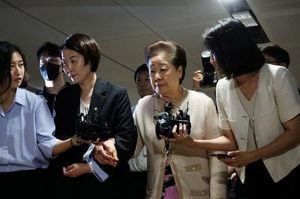Columbia University was thrown under fire earlier this week as anti-Israel activists escalated their penchant for vandalism by pouring cement down toilets across the campus, causing serious plumbing issues and prompting swift condemnation from university administrators.
The incident unfolded on January 30, when members of the activist group Columbia University Apartheid Divest (CUAD) targeted the School of International and Public Affairs (SIPA) and the Kravis Columbia School of Business. Their actions left extensive damage to the plumbing system, leading to the disruption of services across multiple floors of the affected buildings.
According to various reports, the vandals claimed responsibility on social media, declaring, "We left Hind’s call painted on SIPA, and we cemented the sewage lines … forcing them to shut down business-as-usual." The implication was clear: this episode was their response to what they perceived as the university's complicity with Israel, particularly after the expulsion of one of their fellow activists.
"Acts of vandalism of university buildings and property and attempts to harass and intimidate members of our community are unacceptable and abhorrent and will not be tolerated at Columbia," university officials stated, vowing to investigate the matter thoroughly with law enforcement assistance.
The actions didn’t stop with the pouring of cement. Graffiti, including personal attacks against Keren Yarhi-Milo—dean of SIPA—and Rebecca Weiner, the NYPD’s Deputy Commissioner for Intelligence, were also scrawled on building walls. This outburst was particularly shocking for many, as the defacement included messages labeled as disturbing by both university officials and various media outlets.
Reports indicated this significant disruption may have been the culmination of extensive planning sessions held over the preceding months. Activists had gathered at events hosted by Alpha Delta Phi, where literature and strategies encouraging acts of civil disobedience and vandalism were distributed. One activist, captured on video, stated, "Our buildings and our classrooms are spaces for teaching and learning and we cannot permit them to be disrupted and defaced," echoing administrative sentiments. Yet, this was the same environment where plans for sabotage against the university were being strategized.
Notably, CUAD has been growing increasingly vocal on campus, especially following the events of October 7, 2023, when Hamas's actions spurred widespread anti-Zionist activism. An environment has formed where the students are not just expressing dissent but advocating for drastic measures against what they deem oppressive systems, as amplified by their recent actions.
The university has committed to addressing the multitude of incidents surrounding CUAD, with officials discussing potential disciplinary actions against identified students, which could include suspensions. Previously, Columbia acted against students involved in other demonstrations, raising questions about its handling of campus protests and the balance between free speech and property rights.
Add to this atmosphere the temperate responses from administrators who have publicly called for justice and accountability, citing the escalation of violence and vandalism as concerning for both campus safety and the community's wellbeing. The installation of new security measures, including possible bans on masks during protests and collaborations with the NYPD, are under consideration as the university looks to prevent similar disruptions.
This recent uptick of anti-Israel activism hardly seems isolated. With incidents of property damage and extremist rhetoric on the rise, there are fears of more severe unrest. Columbia University may find itself at the heart of this debate surrounding activism, safety, and managing controversial political issues within educational institutions—navigations made ever more complicated by the charged political climate of today.
Activists involved appear unfazed, asserting their motivations as noble highlighted by their willingness to face potential disciplinary consequences. One of them claimed, "We are not experts in what it means to take revolutionary action. We are people—just like you—who, today, chose to act." This defiance raises alarming questions: To what extent is the culture of dissent welcomed on campus, and when does it cross the line from activism to vandalism?
The administration's challenge lies not only within managing the aftermath of these events but also recognizing the broader cultural and political climate which nurtures such radical acts. The stakes could not be higher for Columbia University, as they must navigate this turbulent territory with caution and care.



